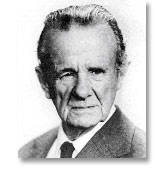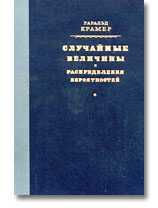|

Harald Cramér
(September 25, 1893 - October 5, 1985).
Harald
Cramér was a famous Swedish
mathematician, actuary and statistician,
specializing in mathematical statistics and
probabilistic number theory. He was
described by John Kingman as "one of the giants of
statistical theory".
 We are fortunate to have his life history told by
Harald Cramér himself. It
is the article
"A century with
probability theory: some personal recollections"
published in The Annals of Probability (1976, Vol. 4,
No. 4, 509-546).
We are fortunate to have his life history told by
Harald Cramér himself. It
is the article
"A century with
probability theory: some personal recollections"
published in The Annals of Probability (1976, Vol. 4,
No. 4, 509-546).
 "...I was born in Stockholm on September 25, 1893, as
the second son of my parents, who
were cousins. Our ancestors had for several centuries lived
in the old town of Wisby, on the
island of Gotland, but my parents lived in Stockholm,
where my father was a banker". [file]
"...I was born in Stockholm on September 25, 1893, as
the second son of my parents, who
were cousins. Our ancestors had for several centuries lived
in the old town of Wisby, on the
island of Gotland, but my parents lived in Stockholm,
where my father was a banker". [file]

Many colleagues left their memoirs about Harald Cramér's
personal life, academic and actuarial professional career.
Some of them are:
1. Blom, G. Harald Cramér
1893-1985, Ann. Statist. 15 (4) (1987), 1335-1350.
2. Blom, G., Matern, B. Bibliography: publications by
Harald Cramér, Scand. Actuar. J.
(1) (1984), 1-10.
3. Bohman, H. Harald Cramér
in memoriam, Scand. Actuar. J. (3-4) (1985), 129-130.
4. Granville, A. Harald Cramér
and the distribution of prime numbers, Harald Cramér
Symposium, Stockholm, 1993, Scand. Actuar. J. (1) (1995),
12-28.
5. Grenander, U. A survey of the life and works of
Harald Cramér, Harald Cramér
Symposium, Stockholm, 1993, Scand. Actuar. J. (1) (1995),
2-5.
6. Jung, J. In memoriam: Harald Cramér,
Mitt. Verein. Schweiz. Versicherungsmath. (2) (1986),
121-122.
7. Kingman, J.F.C. Obituary: Harald Cramér:
1893-1985, J. Roy. Statist. Soc. Ser. A 149 (2) (1986), 186.
8. Leadbetter, M.R. A view of Harald Cramér:
working with the master in his later years, Harald Cramér
Symposium, Stockholm, 1993, Scand. Actuar. J. (1) (1995),
6-11.
9. Masani, P.R. The aftermath of Cramér's
work on stochastic processes, Harald Cramér
Symposium, Stockholm, 1993, Scand. Actuar. J. (1) (1995),
66-96.
10. Wegman, E.J. Some personal recollections of
Harald Cramér on the development
of statistics and probability, Statist. Sci. 1 (4) (1986),
528-535.

The life of Harald Cramér's
is described along the article in Wikipedia as follows.
Harald Cramér was born in
Stockholm, Sweden on September 25, 1893. He remained close
to Stockholm for most of his life. He entered the University
of Stockholm as an undergraduate in 1912, where he studied
Mathematics and Chemistry. During this period, he was a
research assistant under the famous
 chemist,
Hans von Euler-Chelpin, with whom he published his first 5
articles from 1913-1914. Following his lab experience, he
began to focus solely on mathematics. He eventually began
his work on his doctoral studies in mathematics which were
supervised by the famous Hungarian mathematician, Marcel
Riesz, at the University of Stockholm. Also, mentored by G.H.
Hardy, Cramér's research led to a
PhD in 1917 for his thesis "On a class of Dirichlet series". chemist,
Hans von Euler-Chelpin, with whom he published his first 5
articles from 1913-1914. Following his lab experience, he
began to focus solely on mathematics. He eventually began
his work on his doctoral studies in mathematics which were
supervised by the famous Hungarian mathematician, Marcel
Riesz, at the University of Stockholm. Also, mentored by G.H.
Hardy, Cramér's research led to a
PhD in 1917 for his thesis "On a class of Dirichlet series".
Following his PhD, he served as an Assistant Professor of
Mathematics at Stockholm University from 1917 to 1929. Early
on, Cramér was highly involved in
analytic number theory. He also made some important
statistical contributions to the distribution of primes and
twin primes. His most famous paper on this subject is
entitled, "On the order of magnitude of the difference
between prime numbers", provided a rigorous account of the
constructive role in which probability applied to number
theory.
In the late 1920ís, Cramér became
interested in the field of probability, which at the time
was not an accepted branch of mathematics. Cramér
knew that a radical change was needed in this field, and in
a paper in 1926 said, "The probability concept should be
introduced by a purely mathematical definition, from which
its fundamental properties and the classical theorems are
deduced by purely mathematical operations". Cramér
took an interest in the rigorous mathematical formulation of
probability in the work of French and Russian mathematicians
such as Kolmogorov, Levy, Bernstein, and Khinchin in the
early 1930ís. Cramér also made
significant development to the revolution in probability
theory. Cramér later wrote his
careful study of the field in his Cambridge publication
"Random variables and probability distributions" which
appeared in 1937. Shortly after World War II, Cramér
would go on to publish the influential "Mathematical Methods
of Statistics" in 1946. This text was one that "showed the
way in which statistical practice depended on a body of
rigorous mathematical analysis as well as Fisherian
intuition".
 Both
books were translated in Russian. Both
books were translated in Russian.
In 1929, Cramér was appointed to a
newly created chair in Stockholm University, becoming the
first Swedish professor of Actuarial Mathematics and
Mathematical Statistics. Cramér
retained this position up until 1958. During his tenure at
Stockholm University, Cramér was a
PhD advisor for 10 students, most notably Herman Wold and
Kai Lai Chung. Starting in 1950, Cramér
took on the additional responsibility of becoming the
President of Stockholm University. In 1958, he was also
appointed to be Chancellor of the entire Swedish university
system. Dr. Cramér would
eventually retire from the Swedish university system in
1961.
A large portion of Cramérís work
concerned the field of actuarial science and insurance
mathematics. During the period from 1920 to 1929, he was an
actuary for the Swedish life insurance company, Svenska Life
Assurance Company. His actuarial work during this time led
him to study probability and statistics which became the
main area of his research. In 1927 he published an
elementary text in Swedish Probability theory and some of
its applications. Following his work for Svenska, he went on
to work for Sverige, a reinsurance company, up until 1948.
He was also known for his pioneering efforts in insurance
risk theory. After this period, he remained as a consultant
actuary to Sverige from 1949 to 1961. Later in his life, he
was elected to be the Honorary President of the Swedish
Actuarial Society.
Dr. Cramér remained an active
contributor to his professional career for an additional 20
years. Following his retirement in 1961, Cramérís
became extremely active in research, which had been slowed
due to his Chancellorship. During the years from 1961 to
1983, Cramér traveled throughout
the United States and Europe to continue his research,
making significant stops at Berkeley, Princeton, and at the
Research Triangle Institute of North Carolina. His academic
career spanned over seven decades, from 1913 to 1982.
Harald Cramér married Marta
Hanssow in 1918, and they remained together up until her
death in 1973. He had often referred to her as his "Beloved
Marta". Together they had one daughter, Marie-Louise, and
two sons, Tomas and Kim. |


